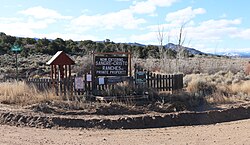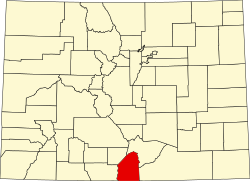Sangre de Cristo Ranches, Colorado | |
|---|---|
 Signs at one of the entrances. | |
Location in the state of Colorado | |
| Coordinates: 37°23′21″N105°20′10″W / 37.38917°N 105.33611°W | |
| Country | |
| State | |
| County | Costilla County |
| Time zone | UTC-7 (MST) |
| • Summer (DST) | UTC-6 (MDT) |
| ZIP code [1] | 81133 (Fort Garland) |
Sangre de Cristo Ranches is an unincorporated community located near Fort Garland in Costilla County, Colorado, United States. The U.S. Post Office at Fort Garland (ZIP Code 81133) serves Sangre de Cristo Ranches postal addresses. [1]


